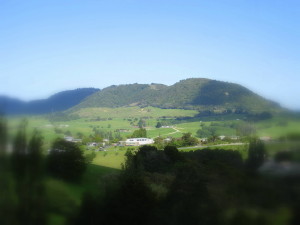The background of
1901
A distant view from
the shoulder of Pukearinga in 1901 was but little different from the picture
presented these fifty years later - a beautiful green basin, sheltered by
mountains on two sides and sloping to a plateau on the north; its placid river
meandering down the centre towards the Kaipara Harbour.
Here were green
fields, good fences, cosy-looking homesteads with well-grown shelter trees, and
roads a-plenty. Assuredly, the farmers, mainly Albertland settlers, had
been very industrious in so changing to productive pastureland, a wilderness of
bush and scrub - all in a span of thirty years.
A closer view,
however, was less pleasing to the stranger accustomed to the lush cocksfoot
pastures of Taranaki. Too much clay soil was in evidence, supporting a
thin growth of the inferior grasses, which were then prevalent. Its
carrying capacity might be estimated at one and a half sheep to the acre.
The roads, although
well laid out, were far from being all-weather roads. Much rutted in
summer, in winter they were largly deep undisguised mud! The best meander
was Bob Ross with his team of bullocks smoothing the surfaces for the few
wheeled vehicles of the settlement.
In 1901, friend Horse
was in his kingdom. He did the small amount of cultivation that was
carried on; drew the few wagons and family buggies, likewise the catamaran and
the sleigh which suited the roads best. The children rode him to school,
the grown-ups to church and concert. It must also be recorded that he
featured in the courtships. A man was known by the horse he rode - the
young bloods sighed "My kingdom for a horse!"
The economic
situation in these years, in most close settlement areas, fell far below the
prosperity of the town and city. There was little money; no railway, good
roads or electricity, mail and newspapers came but twice a week. The farm
produced much of the food for homes which were surprisingly good, lacking none
of the creature comforts. Best of all were those great homemakers, the
wonderful pioneer women.
At the time we review, few of the
farms were large enough to support a family. Cows in small numbers were
usually kept, but dairy butter, bartered at local stores, or, after a toilsome
fourteen miles' journey to Waipu, shipped by the 'Rob Roy' to Auckland, brought
only a sixpence a pound.
Many of the farmers had been
accustomed to augmenting their income by doing outside work such as shearing,
clearing on nearby runs, road making and kauri bush work. By 1901,
however, these supplementary sources of income had practically disappeared and
the settlers were forced to look to their farms to provide a full income.
This, then, was the situation when
the settlers began to consider entering on the new industry of "Co-operative
Dairying". It says a great deal for their courage and optimism that they
disregarded their handicaps and initiated what was actually a local industrial
revolution.


